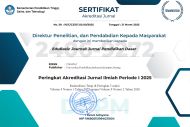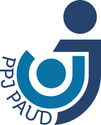Integrasi Kearifan Lokal Masyarakat Baduy Pada Bahan Ajar Tematik Kelas 4 Sekolah Dasar
Abstract
Keywords
Full Text:
PDFReferences
Arifianto, S. (2016). Implementasi Metode Penelitian Studi Kasus. Yogyakarta: Aswaja Pressindo.
Arisetyawan, A. (2014). Studi etnomatematik: Belajar dari budaya Baduy. International Journal of Education and Research, 2 (10), 681-688.
Armawi, A. (2010). Local wisdom: A Solution to surpass hedonism effects on environment pollution. Indonesian Journal of Geography, 42, (2), 119-128.
Cresswell, J. W. (2014). Educational Research Fourth Edition. Great Britain: ARP Impression 98.
Djanuiswaty, E. (n.d.). Mozaic of Banten Indonesia. Serang: Culture & Tourism Service of Banten Province.
Erwinantu. (2012). Peta Wilayah Desa Kanekes. Jakarta: Gramedia Pustaka Utama.
Hamalik, O. (2015). Peranan Kurikulum. In A. H. Hernawan, & R. Cynthia, Kurikulum & Pembelajaran (p. 10). Jakarta: Rajawali Pers.
Kadir, A., & Asrohah, H. (2014). Pembelajaran Tematik. Jakarta: PT Raja Grafindo Persada.
Kemendikbud. (2012). Kurikulum 2013. Jakarta: Kementrian Pendidikan dan Kebudayaan.
Permana, C. E. (2010). Kearifan Lokal Masyarakat Baduy dalam Mitigasi Bencana. Jakarta: Wedatama Widya Sastra.
Permendikbud. (2016). Permendikbud RI 20 tahun 2016 tentang Standar Kompetensi Lulusan Pendidikan Dasar dan Menengah. Jakarta: Kementrian Pendidikan dan Kebudayaan.
Pinasti, V. I. (2017). Diktat Etnografi Indonesia. Yogyakarta: Universitas Negeri Yogyakarta.
Prastowo, A. (2015). Panduan Kreatif membuat Bahan Ajar Inovatif. Jogjakarta: Diva Press.
Prawiradilaga, D. S. (2012). Prinsip Disain Pembelajaran. Jakarta: Kencana Prenada Media Group.
Rusman. (2016). Model-model Pembelajaran Edisi Kedua. Jakarta: PT Raja Grafindo Persada.
Saglam, H. I. (2011). An investigation on teaching materials used in social studies. TOJET: The Turkish Online Journal of Educational Technology, 10 (1), 36-44.
Sugiyono. (2017). Metode Penelitian Pendidikan. Bandung: Alfabeta.
Tomin, A., & Prihatin, I. T. (2012). Baduy, Real Green Living. Jakarta: Canting Exploring Indonesia.
DOI: https://doi.org/10.17509/ebj.v1i1.26481
Refbacks
- There are currently no refbacks.
Copyright (c) 2019 Universitas Pendidikan Indonesia
This work is licensed under a Creative Commons Attribution 4.0 International License.
This journal is indexed by




.png)




.png)
1.png)


1.png)

.png)